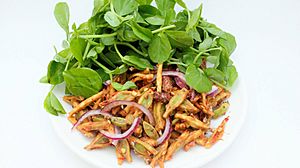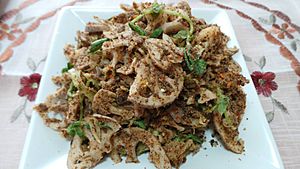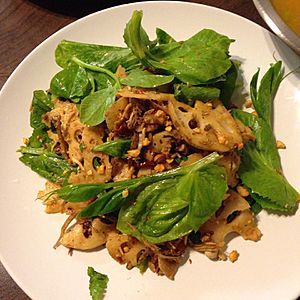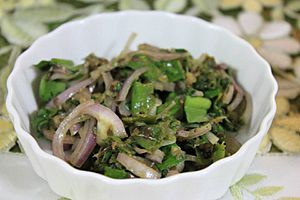Singju facts for kids

Yongchaak Singju. Yongchaak (Stink beans) is accompanied with Hawai maton (sweet pea shoots).
|
|
| Place of origin | India |
|---|---|
| Region or state | Manipur |
| Variations | seasonal vegetables |
Singju (Meitei: ꯁꯤꯡꯁꯨ; pronounced sing-zoo) is a super tasty dish from Manipur, a state in India. It started with the Meitei culture but is now loved by almost everyone in Manipur and even in some nearby states in Northeast India. People often eat Singju as a spicy side dish with their meals, or as a yummy snack in the afternoon or evening.
Singju can be made with many different seasonal vegetables, so there are lots of variations! But there are two main types: one made with Ngari and one made with Thoiding-Besan.
Ngari is a special kind of fermented fish. Its unique flavor is super important in many Manipuri dishes. Singju made with roasted Ngari is very popular in homes. However, it's usually not sold by local vendors because Ngari can be expensive.
That's where the Thoiding-Besan version comes in! Thoiding is an oily seed from a plant called Perilla frutescens. When roasted, it has a nutty taste. A mix of roasted Thoiding and roasted besan (chickpea flour) gives this Singju a delicious and special flavor. This version, without fish, is also served at religious feasts where fish is not allowed.
Contents
How Singju Got Its Name
Manipur used to be an independent kingdom for a very long time before it became part of India in 1949. Because of its long history and different influences, Manipur has many unique customs and traditions.
The word "Singju" comes from two older words: "Manaa-Masing" and "Suba".
- "Manaa-Masing" means green vegetables.
- "Suba" means combining or mixing.
When people say "Manaa-Masing" quickly, it sounds like "Sing". And "Suba" changes to "Ju" to make it easier to say. So, by putting them together, the word "Singju" was created!
How to Make Singju
Singju is a very flexible dish. You can make it vegetarian or non-vegetarian! There are two main ways to prepare it.
Veggie Singju
Vegetarian Singju is mostly served at special events or religious feasts for the Meitei people. These events often happen in home courtyards, shrine yards, or community centers. People can eat it at home too, but they usually prefer the non-vegetarian kinds for everyday meals.
For this type of Singju, the main ingredients are:
- Perilla seeds (called thoiding in Meitei)
- Chickpea flour (chanaa powder)
- Salt
- Chillies
- Different green leafy vegetables (see the list below for popular ones!)
Non-veg Singju
The non-vegetarian version of Singju is usually eaten at home. It's also very popular and sold in restaurants all over Manipur and in some other parts of India. It's called "non-veg" because it uses Ngari, the special Manipuri fermented fish. Because of the fish, this version cannot be served at religious feasts, which must be vegetarian.
For this type, the main ingredients are:
- Ngari (the Manipuri fermented fish)
- Salt
- Chillies
- Green leafy vegetables (check out the list below for ideas!)
Popular Vegetables for Singju
You can use almost any vegetable to make Singju, but some are much more popular than others. Here are some common additions:
- Lotus stem (called Thambou in Meitei)
- Stink Bean (Yongchaak)
- Cabbage (Kobiful)
- Cauliflower (Kobi-Lei)
- Hawai Debi or Tebi
- Hawai Maton
- Unripe Papaya (Awaa Thabi)
- Banana Flower (Laphu Tharo)
- Rice Bean (Chakhawai)
- Onion (Tilhou)
Morok Metpa: A Similar Dish
Morok Metpa or Ametpa is another dish that's a bit like Singju. The word Morok means chilli, and Metpa/Ametpa means to crush. This dish is usually eaten with daily meals at home, but it's not served at special religious events.
Just like Singju, Morok Metpa can be made in two ways: vegetarian and non-vegetarian. The vegetarian one is often eaten during special times when people don't eat fish or meat because of their beliefs. This vegetarian version is usually made by frying red chillies, chives, and onions. The everyday version is often made with steamed or roasted fermented fish and chillies.




